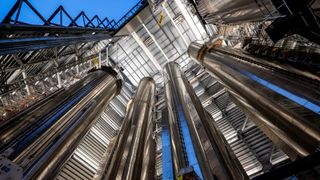
SpaceX shared this photo of four Super Heavy boosters in the “megabay” at its Starbase site via X on Feb. 2, 2024.
(Image credit: SpaceX via X)
SpaceX wants to launch its giant Starship vehicle often over the coming months, as a new photo makes abundantly clear.
In a post on X this afternoon (Feb. 2), SpaceX shared photos of the “megabay” at its Stabase site in South Texas, the center of Starship manufacturing and launch activities.
The building is jam-packed with towering stainless-steel cylinders — Super Heavy vehicles, the first stage of SpaceX’s Starship megarocket — which rise nearly to the roof.
“Super Heavy boosters for the next three flights, with a fourth ready to stack, in the Starbase Megabay,” SpaceX wrote in the post.
Related: See stunning photos and video of Starship’s 2nd launch

Another shot of the Super Heavy boosters, with some people in it for scale. (Image credit: SpaceX via X)
Starship consists of two elements, both of which are designed to be fully and rapidly reusable: Super Heavy and a 165-foot-tall (50 meters) upper-stage spacecraft called Starship.
When fully stacked, Starship stands about 400 feet (122 meters) tall. It’s the biggest and most powerful rocket ever built, capable of launching up to 150 tons of payload to low Earth orbit, according to SpaceX’s spec sheet.
Starship isn’t up and running yet, however; it has launched just twice to date, on test flights in April and November of last year. Both ended in powerful explosions. But Starship made enough progress on the second liftoff — acing a full-duration Super Heavy burn and successfully separating its two stages, for example — that success seems like a real possibility on flight number three, which may be just around the corner.
Indeed, SpaceX aims to launch the test mission this month, provided it secures a launch license from the U.S. Federal Aviation Administration in time. (The FAA is overseeing an investigation into what happened on the November flight.)
SpaceX thinks that Starship’s combination of power and reusability will lead to huge breakthroughs in exploration, allowing humanity to put down stakes on the moon and Mars.
NASA sees promise in the vehicle: It selected Starship to be the first crewed moon lander for its Artemis program, which aims to establish a permanent human presence on and around Earth’s nearest neighbor by the end of the 2020s. Starship will put astronauts down on the lunar surface for the first time in 2026, on the Artemis 3 mission, if all goes according to plan.
Join our Space Forums to keep talking space on the latest missions, night sky and more! And if you have a news tip, correction or comment, let us know at: [email protected].
Breaking space news, the latest updates on rocket launches, skywatching events and more!
Michael Wall is a Senior Space Writer with Space.com and joined the team in 2010. He primarily covers exoplanets, spaceflight and military space, but has been known to dabble in the space art beat. His book about the search for alien life, “Out There,” was published on Nov. 13, 2018. Before becoming a science writer, Michael worked as a herpetologist and wildlife biologist. He has a Ph.D. in evolutionary biology from the University of Sydney, Australia, a bachelor’s degree from the University of Arizona, and a graduate certificate in science writing from the University of California, Santa Cruz. To find out what his latest project is, you can follow Michael on Twitter.
>>> Read full article>>>
Copyright for syndicated content belongs to the linked Source : Space.com – https://www.space.com/space-starship-super-heavy-next-three-flights-photos













![[News] Japan Develops 10nm Nanoimprint Technology, with Potential to Tackle EUV Bottleneck – TrendForce](https://earth-news.info/wp-content/uploads/2025/12/329851-news-japan-develops-10nm-nanoimprint-technology-with-potential-to-tackle-euv-bottleneck-trendforce-360x180.jpg)
















